Lactobacilli and their probiotic properties
Authors:
H. Kiňová Sepová; A. Bílková; M. Bukovský
Authors‘ workplace:
Univerzita Komenského v Bratislave, Farmaceutická fakulta, Katedra bunkovej a molekulárnej biológie liečiv
Published in:
Čes. slov. Farm., 2008; 57, 95-98
Category:
Review Articles
Overview
Lactobacilli rank among lactic acid bacteria, fermenting saccharides to produce lactic acid. The individual species and strains differ by the profiles of fermented saccharides, but this property is not sufficient for the identification at the species level. The species and strains differ in the 16S rDNA sequence and in the intergenic space between 16S and 23S rDNA, which make their differentiation and identification possible. Some representatives of the genus Lactobacillus are included in probiotic preparations with regard to their beneficial health effects on the human and animal organisms. For example, they are able to interact with the immune system and stimulate it positively, to reduce the manifestations of lactose intolerance by consuming fermented milk products, and to shorten postantibiotic and travellers’ diarrhoea. Lactobacilli also produce bacteriocins, antimicrobially active substances.
Key words:
Lactobacillus – probiotics – bacteriocins – bacteria of lactic fermentation – 16S rDNA
Sources
1. Ouwehand, A. C., Salminen, S., Isolauri, E.: Antonie Leeuwenhoek, 2002; 82, 279–289.
2. Salminen, S., Isolauri, E., Salminen, E.: Antonie Leeuwenhoek, 1996; 70, 347–358.
3. Gismondo, M. R., Drago, L., Lombardi, A.: Int. J. Antimicrob. Agents, 1999; 12, 287–292.
4. www.who.int/entity/foodsafety/publications/fs_manage ment/probiotics2/en, 15. 3. 2007.
5. www.who.int/foodsafety/fs_management/en/probiotic_ guidlines.pdf, 9. 3. 2007.
6. www.bacterio.cict.fr/index.html, 18. 12. 2007.
7. Heilig, H. G. H. J., Zoetendal, E. G., Vaughan, E. E. et al.: Appl. Environ. Microbiol., 2002; 68, 114–123.
8. Wilson, K. H., Blitchington, R. B.: Appl. Environ. Microbiol., 1996; 62, 2273–2273.
9. Claesson, M. J., Li, Y., Leathy, S. et al.: Proc. Natl. Acad. Sci, 2006; 107, 6718–6723.
10. Anukam, K. C., Osazuwa, E. O., Ahonkhai, I., Reid, G.: World J. Microbiol. Biotechnol, 2006; 22, 1055–1060.
11. Kleerebezem, M., Boekhorst, J., van Kranenburg, R. et al.: Proc. Natl. Acad. Sci., 2003; 100, 1990–1995.
12. Tannock, G. W., Tilsala-Timisjarvi, A., Rodtong, S. et al.: Appl. Environ. Microbiol., 1999; 65, 4264–4267.
13. Oneca, M., Irigoyen, A., Ortigosa, M., Torre, P.: FEMS Microbiol. Lett., 2003; 227, 271–277.
14. Sánchez, I., SeseĖa, S., Poveda, J. M. et al.: Int. J. Food Microbiol., 2006; 107, 265–273.
15. van de Guchte, M, Penaud, S., Grimaldi, C. et al.: Proc. Natl. Acad. Sci., 2006; 103, 9274–9279.
16. Spano, G., Beneduce, L., de Palma, L. et al.: World J. Microbiol. Biotechnol, 2006; 22, 769–773.
17. Pridemore, R. D., Berger, B., Desiere, F. et al.: Proc. Natl. Acad. Sci. USA, 2004; 101, 2512–2517.
18. Beneduce, L., Spano, G., Vernile, A. et al.: Basic Microbiol., 2004; 44, 10–16.
19. Bourdineaud, J. P., Nehme, N., Tesse, S., Lonvaud-Funel, A.: Appl. Environ. Microbiol., 2003; 69, 2512–2520.
20. Aymerich, T., Martin, B., Garriga, M., Hugas, M.: Appl. Environ. Microbiol., 2003; 69, 4583–4594.
21. Balows, A. et al.: The prokaryotes. 2. vyd. New York, Springer, 1992. s. 1564.
22. Maldonado, A., Ruiz-Barba, J.L., Jiménez-Díaz, R.: Arch. Microbiol., 2004; 181, 8–16.
23. Holzapfel, W. H., Haberer, P., Geisen, R. et al.: Am. J. Clin. Nutr., 2001; 73, 365S–373S.
24. Quere, F., Deschamps, A., Urdaci, M. C.: J. Appl. Microbiol., 1997; 82, 783–790.
25. Colins, M. D., Rodrigues, U., Ash, C. et al.: FEMS Microbiol. Lett., 1991; 77, 5–12.
26. Berthier, F., Ehrlich, S. D.: FEMS Microbiol. Lett., 1998; 161, 97–106.
27. Martius, G., Breckwoldt, M., Pfleiderer, A.: Gynekologie a porodnictví. Martin, Osveta, 1997, s. 22, 427.
28. Holzapfel, W. H., Haberer, P., Snel, J. et al.: Int. J. Food Microbiol., 1998; 41, 85–101.
29. Simon, G. L., Gorbach, S. L.: Med. Clin. North Am., 1982; 66, 557–574.
30. Kaila, M., Isolauri, E., Soppi, E. et al.: Ped. Res., 1992; 32, 141–144.
31. Isolauri, E., Kaila, M., Arvola, T. et al.: Ped. Res., 1993; 33, 1605–1610.
32. Surawitz, C. M., Elmer, G. W., Spleeman, P. et al.: Gastroenterol., 1989; 96, 981–988.
33. Goldin, B. R., Gorbach, S. L.: Am. J. Clin. Nutr., 1984; 39, 756–761.
34. Biffi, A., Coradini, D., Larsen, R. et al.: Nutr. Canc., 1997; 28, 93–99.
35. Hirayama, K., Rafter, J.: Antonie Leeuwenhoek, 1999; 76, 391–394.
36. van Houte, J.: J. Dent. Res., 1994; 73, 672–681.
37. Hanhn, C. L., Falkler Jr., W. A., Minah, G. E: Arch. Oral Biol., 1991; 36, 147–153.
38. Hoshino, E., Ando, N., Sato, M., Kota, K.: Int. Endod. J., 1992; 25, 2–5.
39. Cannon, J. P., Lee, T. A., Bolanos, J. T., Danziger, L. H.: Eur. J. Clin. Microbiol. Infect. Dis., 2005; 24, 31–40.
40. Christensen, H. R., Frokiaer, H., Pestka, J. J.: J. Immunol., 2002; 168, 171–178.
41. Hart, A. L., Lammers, K., Brigidi, P. et al.: Gut, 2004; 53, 1602–1609.
42. Smits, H. H., Engering, A., van der Kleij, D. et al.: J. Allergy Clin. Immunol., 2005; 115, 1260–1267.
43. Buck, B. L., Altermann, E., Svingerud, T., Klaenhammer, T. R.: Appl. Environ. Microbiol., 2005; 71, 8344–8351.
44. Pretzer, G., Snel, J., Molenaar, D. et al.: J. Bacteriol., 2005; 187, 6128–6136.
45. Marco, M. L, Pavan, S., Kleerebezem, M.: Curr. Opin. Biotechnol., 2006; 17, 204–210.
46. Tagg, J. R., Dajani, A. S, Wannamaker, I. W.: Microbiol. Rev., 1976; 40, 722–756.
47. Klaenhammer, T. R.: FEMS Microbiol. Rev., 1993; 12, 39–86.
48. Kabuki, T., Saito, T., Kawai, Y. et al.: Int. J. Food Microbiol., 1997; 34, 145–156
49. Hall, R. H., Stern, E. S.: J. Chem. Soc., 1950; 490–498.
Labels
Pharmacy Clinical pharmacologyArticle was published in
Czech and Slovak Pharmacy

2008 Issue 2
Most read in this issue
- Semisynthetic cellulose derivatives as the base of hydrophilic gel systems
- Lactobacilli and their probiotic properties
- Standard prescriptions for the formulation of medicinal preparations in pharmacies I. Suspensions for dermal administration
- Medicinal plants and diabetes mellitus
